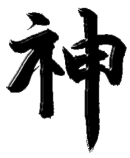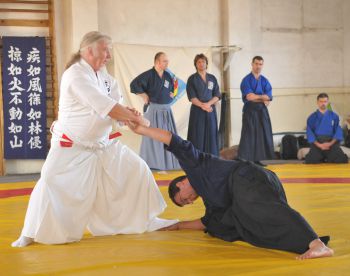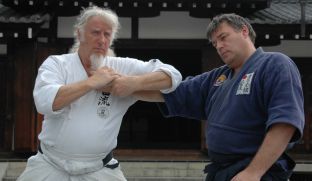
- Guard always with right foot forwards according to the posture of the Japanese swordsmen of the past. Defence however is not limited to a single side as some narrow-minded people could imagine...
- The technical bases do not contain any form of attack and are always practiced right to left with change of guard since they are basically educational.
- Bare hand techniques are very old and were formerly used on the battlefield. They are a particular to the Takeda School even if some of them resemble those used in other schools under different names.
- Atemis with the edge of the hand are much used whereas in many traditional schools they tend to disappear; training on the partner’s body is done with a special glove(Sogo).
- In practice most techniques end up by an immobilisation on the floor in the form of arm/elbow or wristlocks called AÏKI-GOSHIN-JITSU-WAZA in Japan and AÏKI-GOSHINDO-WAZA in Europe.
- The Takeda Ryu School awards its own ranks and certificates (Menkyo) and is not dependent on any international or national organization. Its infrastructure is established according an internal hierarchy.
- At least three disciplines have to be mastered to claim to excel in Subudo (set of martial arts) and to obtain an AÏKI-GOSHINDO TAKEDA-RYU MAROTO-HA instructor certificate.
Aikido , aiki-jujutsu, ju-jutsu or iaido are in fact just parts of a whole and are not enough in themselves.
PETICULARITIES
Zen

When I started my takeda Ryu Maroto ha training I had to accept that the content and form were a one and only thing. The attitude is either right or wrong. Etiquette, curtsy are at the same time a display of respect due to the other and gages of efficiency.
As of the salute, your eyes, bearing of the head, clothes, way of putting your hands or feet give the tune. The combatant generally remains respectful to others but at the same time is ready to fight. The general attitude is the answer to the combatant’s intent.
Prisoner of the numerous techniques learnt and gathered here and there I had to forget to learn afresh…and not try to answer when no question had been asked. Contrary to martial art sports the Takeda Ryu method does not limit the number of answers. It is a school of freedoms which does not confine the partner to the role of the adversary. Armed or not, using his fists or his feet or just grabbing the partner asks a question. The answer first lies in adapting yourself and being self-possessed I was very much impressed by the different guards used in the school which shorten the time between defence and attack to nearly simultaneity. This thanks to a skilful positioning of the body and its members.
In Ju Kenpo for instance, fluidity favours speed without sacrifying protection. It resembles Kendo without Shinai. Same explosion in the fight, same determination and same precision.
The school’s Aikido before being a Way really is a Jutsu rooted in principles validating techniques. Before studying a technique the attitude has to be understood: keep one’s centre, let one’s body move to create the void necessary to the adversary’s absorption. Technique then comes to shorten the time needed to answer but certainly does not substitute itself to the principle. The partner who “receives” must also “give”. It is not a game. There are no martial choreographies where the combatants are being ridiculed because of the complicities involved. Combatants have been lucky never to be involved in real combat. Here it is not uke’s role to be in harmony with tori. This is the role of the one who is learning to defend themselves to be in harmony with the distances and tempos decided by the partner.
The school’s Iaido needs two partners at a distance which enables them to express themselves in total security. There is no question of self-hypnotising oneself facing a mirror reflecting a satisfied ego. There is no question of being quick just to touch the other. The “sharp spirit” must be adopted to chop the enemy in one go. Otherwise how can be intended to chop with a real sabre?
Contrary to martial arts which favour specialisation Takeda Ryu fulfils its educational role without placing the horse before the cart. For instance repeating a wrong move which transforms itself into a reflex can be fatal if the student was led to defend themselves in reality.
Limiting the budo to combat however would be a mistake. The principles of this school are to be used in every day life. I was pleasantly surprised by the instructors ways of thinking Never a hard word for this or that particular martial art school. Just a malicious look when a combatant clang stubbornly to his way of practicing. It is this old school’s privileged not to have to demonstrate its legitimacy. History already did. Instead of persuading the teachers show and explain. Students accept and question their own capacities and knowledge. Or they have such an important ego that they decide to abandon.
The Takeda Ryu MAROTO-HA method invites the student to accept the other not out of fera or weakness- just looking at them move on a tatmi is enough to realise this- but because life is on opening. The respect and practice of these ancient forms are the keepers of the perfect transmission of this secular knowledge to the generations to come.
The method Maroto-ha of the school Takeda-ryu
teaches a set of 7 disciplines:
Aïki-jutsu - Iaï-do - Tachi-ken-jutsu
Ju-kenpo - Jod - Shugi-jutsu - Shuriken-jutsu
It is this set of 7 disciplines that forms Takeda Ryu So Budo.
What’s different about master Maroteaux’s art compared to other combat sports splendid and efficient as they may be?
The school’s antique Jui Jutsu teaches THE ART AND WAY of dealing with one or several attackers be they armed or not and being themselves EXPERTS in martial arts and not occasional aggressors or fighting under consumption of drugs or other products limiting their physical abilities. It is hence not a game. Always think of the fact that the person attacked is always alone. They will not be helped. No policeman or any passer- by at this particular moment. The victim will undergo the aggression, lodge a complaint and wait two or three years and a half for compensation. This must be known!
Without looking to submit the other in no should someone undergo a physical attack or thesort of verbal ones we have grown accostumed to in our society.
The TAKEDA-RYU MAROTO-HA branch is no more than a by product from the original Takeda Ryu with its own specificities. In fact it is essentially a method of teaching and working based on intuition and spontaneity.
To the original style other techniques coming from other famous traditional Japanese schools are added:
Aikikai - for circular movements.
Yoshin-kai - for postures and guards.
Hakko-ryu - for health techniques.
As the family tree shows it Minamoto-no Maroto has worked
with quite a number of Japanese masters such as :
for Aikikai : Koichi Tohei, Nobuyoshi Tamura, Masamichi Noro, Kazuo Chiba,...
for Yoshin Kai : Gozo Shioda, Kiyoyuki Terada, Tadao Ogawa, ...
for Hakko Ryu : Ryuho Okuyama, Toshio Okuyama, Hisamitsu Mimurodo, Kozan
Terasawa, Takeshi Dogane, Yasuhiro Irie, Michio Watanabe, Kimiteru Mimurodo...
for Takeda Ryu : Hisashi Nakamura, Toshihisa Sofue, Masayuki Toyoshima,
Miyoshi Morita, ...
The Takeda Ryu maroto Ha has preserved many of the ancestral techniques inherited from the battlefield where every single combatant had to face death confronted to enemies as fearsome as they were experts. Most of these techniques had never been revealed in west. Up to here...
Other particularities of the method
- The study of the instinctive basic defence postures low and steady observing right angles
- The study of the Ma-ai distance according to the position of one or several adversaries without being influenced by whatever movement strategy.
- The study of a specific guard right foot forward and always facing the adversary
- The study of self-possession irrespective of what is to come through ventral breathing
- The study of how to rid oneself of an adversary in three seconds as soon as the later has launched his attack
- The study of a philosophical concept which consists in never seeking to carry out a technique on someone but to prevent the adversary from carrying one out on you
- The study of non-action within action
- The study of a maximum level of efficiency with a minimum of efforts in as a short time as possible.
An army « Quick...as the wind; Majestic...as the forest; Voracious...as the fire, Immutable...as the mountain. »
Poem extracted from Chinese military literary classic Sonshi
Such was the slogan of the general TAKEDA SHINGEN. This ambition, this strategy recovers from the BUDO, that is from the global education of the samurai. In XXIst century, far from the country of the rising sun, to want to live a BUDO takes the shape of a quest or a dream… With in background the risk to find only a cosmetical martial art…

Teaching and Peticularities
AIKI-JU JUTSU TAKEDA-RYU MAROTO-HA
World Takeda-Ryu Marotokan Federation - International Official Site





